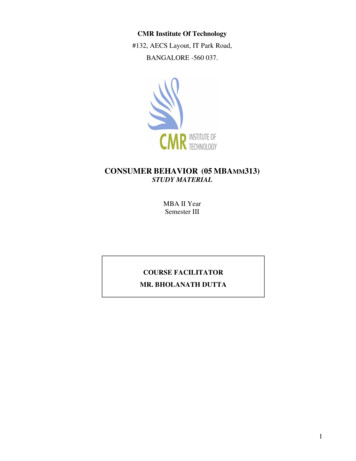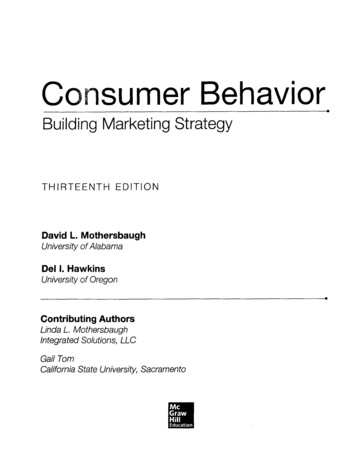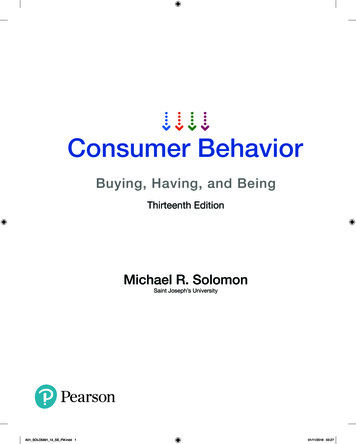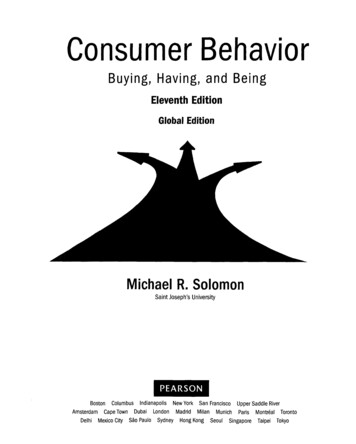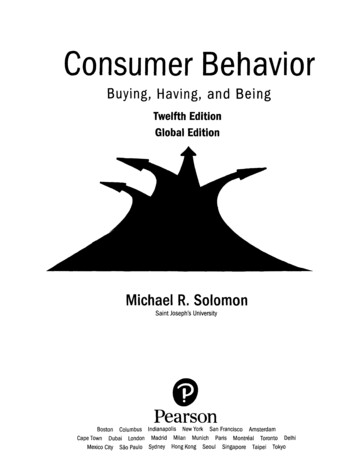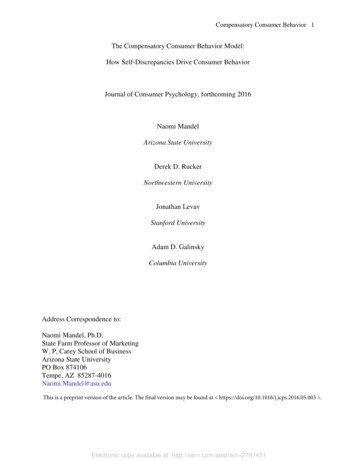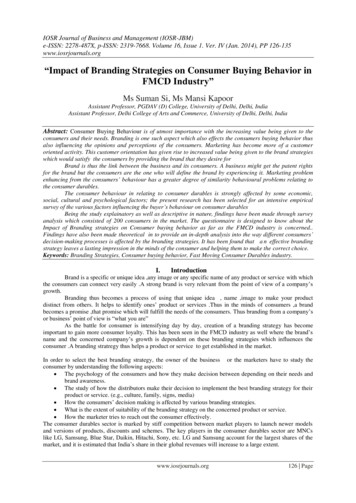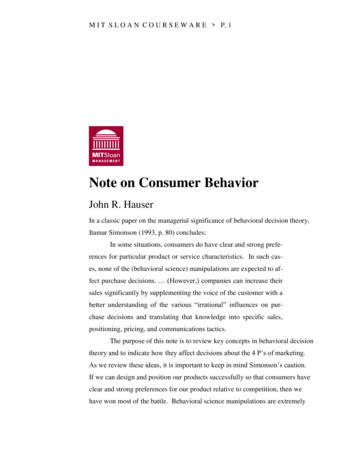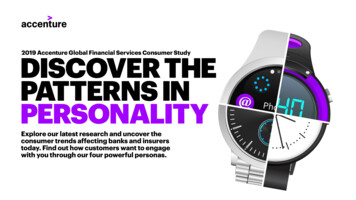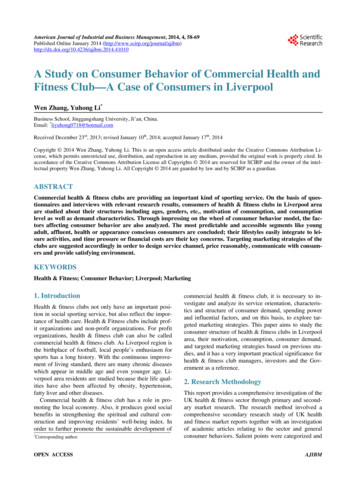
Transcription
American Journal of Industrial and Business Management, 2014, 4, 58-69Published Online January 2014 org/10.4236/ajibm.2014.41010A Study on Consumer Behavior of Commercial Health andFitness Club—A Case of Consumers in LiverpoolWen Zhang, Yuhong Li*Business School, Jinggangshang University, Ji’an, China.Email: *liyuhong0718@hotmail.comReceived December 23rd, 2013; revised January 10th, 2014; accepted January 17th, 2014Copyright 2014 Wen Zhang, Yuhong Li. This is an open access article distributed under the Creative Commons Attribution License, which permits unrestricted use, distribution, and reproduction in any medium, provided the original work is properly cited. Inaccordance of the Creative Commons Attribution License all Copyrights 2014 are reserved for SCIRP and the owner of the intellectual property Wen Zhang, Yuhong Li. All Copyright 2014 are guarded by law and by SCIRP as a guardian.ABSTRACTCommercial health & fitness clubs are providing an important kind of sporting service. On the basis of questionnaires and interviews with relevant research results, consumers of health & fitness clubs in Liverpool areaare studied about their structures including ages, genders, etc., motivation of consumption, and consumptionlevel as well as demand characteristics. Through impressing on the wheel of consumer behavior model, the factors affecting consumer behavior are also analyzed. The most predictable and accessible segments like youngadult, affluent, health or appearance conscious consumers are concluded; their lifestyles easily integrate to leisure activities, and time pressure or financial costs are their key concerns. Targeting marketing strategies of theclubs are suggested accordingly in order to design service channel, price reasonably, communicate with consumers and provide satisfying environment.KEYWORDSHealth & Fitness; Consumer Behavior; Liverpool; Marketing1. IntroductionHealth & fitness clubs not only have an important position in social sporting service, but also reflect the importance of health care. Health & Fitness clubs include profit organizations and non-profit organizations. For profitorganizations, health & fitness club can also be calledcommercial health & fitness club. As Liverpool region isthe birthplace of football, local people’s enthusiasm forsports has a long history. With the continuous improvement of living standard, there are many chronic diseaseswhich appear in middle age and even younger age. Liverpool area residents are studied because their life qualities have also been affected by obesity, hypertension,fatty liver and other diseases.Commercial health & fitness club has a role in promoting the local economy. Also, it produces good socialbenefits in strengthening the spiritual and cultural construction and improving residents’ well-being index. Inorder to further promote the sustainable development of*Corresponding author.OPEN ACCESScommercial health & fitness club, it is necessary to investigate and analyze its service orientation, characteristics and structure of consumer demand, spending powerand influential factors, and on this basis, to explore targeted marketing strategies. This paper aims to study theconsumer structure of health & fitness clubs in Liverpoolarea, their motivation, consumption, consumer demand,and targeted marketing strategies based on previous studies, and it has a very important practical significance forhealth & fitness club managers, investors and the Government as a reference.2. Research MethodologyThis report provides a comprehensive investigation of theUK health & fitness sector through primary and secondary market research. The research method involved acomprehensive secondary research study of UK healthand fitness market reports together with an investigationof academic articles relating to the sector and generalconsumer behaviors. Salient points were categorized andAJIBM
A Study on Consumer Behavior of Commercial Health and Fitness Club—A Case of Consumers in Liverpoolpriorities identified to be tested through primary research.A questionnaire was developed to test the points for alocal representative sample of consumers (see appendixes). The results were then compared and analyzed. Theprimary research used a quantitative based approachsampling local consumers.Solomon et al. [1] proposes a “wheel of consumer behavior” to help explain the complex interrelationshipsbetween individual consumers and their social realities(see Figure 1). In the context of a health and fitnessconsumer this provides a useful framework for understanding the forces and processes that are impacting uponconsumers and affect their behaviors.3. Literature Review3.1. Consumer StructureSwimming is a factor for families, but those with children are less likely to exercise frequently. Family dynamics are important in determining usage behavior, but finances have critical impacts on decision making [2]. Gender can also relate to how service empathy is provided.Research shows that females are more predisposed with a59preference to talk about reasons for exercising and theirgoals with other females [3]. Similarly, existing lifestylematches have stronger impacts on consumers, when participants’ lifestyles are similar to those targeted [4].3.2. MotivationSignificant numbers of consumers never exercise andappear to have no interest in joining a health club. Lackof interest appears to be the reason for a third of consumers, while cost of use of public facilities is an inhibitor for 13% of consumers [5]. Ownership of fitnessequipment is increasingly popular as home workout provides greater time and frequency flexibility, but facescompetition from other home entertainment trends [6].Exercise is considered leisure behavior, but offers aprospect of an external reward [7]. The research sets outprincipal incentives as relaxation, stress relief; social/self-improvement, appearance/self-esteem and competence challenge [8]. There is a trend towards health andthis may be reflected in the increasing popularity of outdoor fitness [5]. Health conscious consumers (or wellness-oriented) are more interested in more holistic lifeFigure 1. Solomon’s Wheel of Consumer Behavior (Solomon, Bamossy, Askegaard, & Hogg, 2010) [1].OPEN ACCESSAJIBM
60Current Distortion Evaluation in Traction 4Q Constant Switching Frequency Convertersstyles, concerned with “nutrition, fitness, stress and theirenvironment” [9].for experienced users, the artifacts and equipment areparamount [3].3.3. Consumption3.6. Targeted Marketing StrategiesFamily recreation needs and higher standards of livingcreated growth in private fitness and health clubs, thoughtrends towards busier consumer lifestyles and the economic downturn now mean that consumers seem lessable to commit to regular fitness, sports and competitions[2]. Respondents state that they do not have time to exercise, find it un-enjoyable, and become intimidated and/oranxious [10]. As health and fitness is leisure time based,lifestyle is an important factor. Whilst many indicatesport is important to them, lack of time/energy or financial reasons inhibits consumption [2]. Negative attitudesseem more prevalent than positive ones towards exercise.Private Health Clubs tend to use structural and financialmethods to retain customers, but this is easily imitatedand does not work to establish real social bonding between them. Creating loyalty by attitudinal and social relationships and to engender positive word of mouth maybe more successful [13]. Loyalty appears to relate to lifecycle as younger members of health clubs (18 to 24)are more willing to switch clubs, whereas, families withchildren and “third agers” (55 ) seem more loyal [16].Consumers tend to exercise for longer periods at theweekends as opposed to only half hour midweek and alack of convenience can inhibit [12]. Large private gymsare more urban with “original suburb” and “city adventurers” prominent [2].3.4. Demand CharacteristicsSwimming, cycling, aerobics and fitness classes are popular fitness activities [2], although [11] highlight walkingand jogging as prevalent, high frequency and trending.Fitness classes help introduce a social element to classesand activities such as aerobics, circuit training, yoga,martial arts and dance attract between 6% and 11% ofconsumers [12]. Regular users of health and fitness clubsuse more involved decision making as they perceivemore risk [13]. Consumers exercise in a group or on theirown, but social bonding need is highly unpredictable inindividuals [7]. Singular consumers’ expectations towards the levels of service offered by staff depend upontheir self-responsibility levels [3].3.5. Influential FactorsSelf-concepts influence the level of concern towards ownweight, fitness levels as well as anxiety associated withencountering other members, staff and equipment [3].Psychological involvement in health and fitness influences levels of activity importance to the individual, theirlevel of interest and frequency of cognition [8]. Deeprooted psychological preoccupations with gender or bodyconsciousness/former health, mental or emotional problems influence consumer’s interest and motivation andhow health club empathy is assessed [3], in fact, psychological variables like perceived health status may be better predictors of health behaviors than demographics [14].The image of a fit body is increasingly a mark of socialstanding and for some segments the drive is to look goodrather than feel healthy [15]. Needs may depend uponracial, cultural and religious factors. For example, trueempathy with the needs of ethnic sub-groups can addgreatly to service value for those consumers, converselyOPEN ACCESS4. Research ResultsThe results of the primary research undertaken are compared with secondary research to test the main premises,using Solomon’s “wheel of consumer behavior” as thestructural framework (see Figure 1).4.1. Consumers in the MarketplaceConsumers are finding ways of exercising for less financial expenditure [5,6]. From the primary research, financial reasons for not joining were 26.67% with free outdoor activities preferred by 17.33% of the sample. Thisdemonstrated that financial reasons are an important inhibitor and some consumers will select the available alternatives.Consumers use affordability, convenience, cleanliness,club status and clientele as core factors [2,5]. The primary research partly reinforced this with the most importantfactor as price (30.77%), second convenience (27.47%)and third facilities (20.88%). Brand status was not important within the sample.The importance of “service-support needs” varies depending upon the self-reliance, knowledge/expertise levels [3]. Primary research showed that service supportneed was not a strong factor at 10.99% but that consumers sampled had mixed responses to competitors servicelevel, Services appear important for reducing anxiety as(24.14%) of the sample thought personal-trainers mayreduce equipment concerns.Significant numbers of consumers never use healthand fitness clubs [2,5]. This was supported by primaryresearch as results indicated 35.16% of the sample neverexercised. This was similar to the Keynote survey resultsof 35%.AJIBM
A Study on Consumer Behavior of Commercial Health and Fitness Club—A Case of Consumers in Liverpool4.2. How Consumers See the World andThemselvesExercise is used to improve body-image and self-esteem,to improve health, fitness and strength and to achieveproficiency challenges [8]. In the primary research, 30.82%stated that improving health was their main motivation,followed by “to lose weight” (23.29%), “look good”(14.38%) and “relax” (11.64%). Perceptions regardingown body-image/fitness-levels in relation to individual’sideals creates motivation [6,8,15,17]. The primary research showed that concerns were stronger for health inthe sample.Body image is an important component of status/selfesteem and has a social “currency” [15,6]. The primaryresearch did not strongly validate this hypothesis ashealth goals were more prevalent than “looking good”.Consumers are more likely to be anxious regarding theirhealth and fitness levels at specific stages of their lifecycle [15]. The primary research indicated that gymmembership was most attractive to 16 to 35 year olds.Deeply ingrained gender/body awareness affects anxiety levels regarding use of health clubs [3,15]. Genderseparation and more privacy were cited as helpful forreducing anxiety for some consumers in the primary research.Males are increasingly subjected to objectification ofthe body, although bulk and not tone is the desired outcome [15]. The primary research did not strongly validate this as health goals and reducing weight werestronger results although there was preference amongstmales to improve self-esteem and socialize.Consumers often have negative attitudes to fitness dueto a lack of satisfaction, enjoyment or frustration withresults [6]. The primary research indicated that timepressures (32.00%) was the main inhibitor, 8% foundexercise boring, while 5.33% lacked energy.Participants become psychologically attached to particular activities [7]. The primary research failed to support this with weak results for previous experience asfactors in choices.4.3. Consumers as Decision MakersFinancial structures to retain customers are reproducible,while empathizing with consumers needs attracts psychological loyalty [18,19]. The primary research indicated that subscription and pay as you go models wereequally popular and that other factors such as price, facilities and convenience were more important factors thanservices.Family cycle stages affect consumption since childcare commitments impact upon time-availability andfamily-recreation behaviors [2]. The results from theprimary research were skewed by a lack of parents parOPEN ACCESS61ticipating in the survey and family friendly preference(7.69%) reflected this. Family memb
using Solomon’s “wheel of consumer behavior” as the structural framework (see . Figure 1). 4.1. Consumers in the Marketplace. Consumers are finding ways of exercising for less finan-cial expenditure [5,6]. From the primary research, finan-cial reasons for not joining were 26.67% with free out-door activities preferred by 17.33% of the sample. This demonstrated that financial reasons are .
